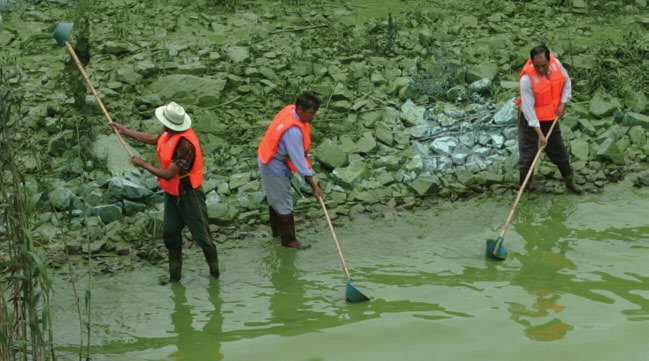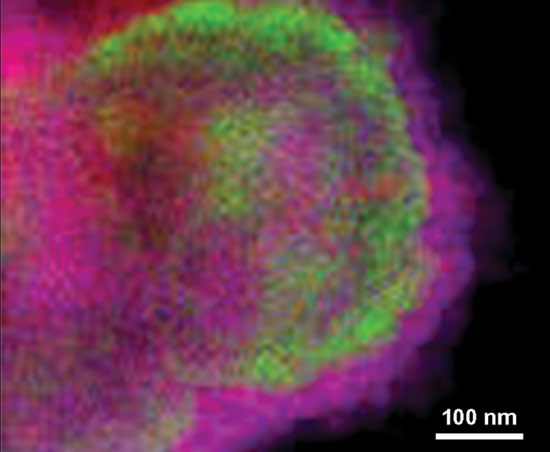Wei-xian Zhang, professor of civil and environmental engineering, was working in his lab, pondering oil spills in the Gulf of Mexico and in Dalian, China, when a call came from Hoboken, New Jersey. A pedestrian had smelled fumes in one of the city’s brownstone neighborhoods. Police had discovered heating oil gushing from a corroded tank beneath the sidewalk in front of a house.
Zhang, who applies nanotechnology solutions to some of the world’s most notorious environmental disasters, knew time was of the essence. The leak had to be stopped and the oil removed before it spread farther into the soil and groundwater.
Ten years ago, Zhang recalled as he drove to Hoboken, a construction crew would have rushed to the scene to perform an intervention as elaborately choreographed, and almost as dated, as the million-dollar brownstone’s ornate facade. Inch by inch, workers would have jacked the house off its foundation. A backhoe would have dug up the tainted soil to a depth of dozens of feet, and a line of trucks would have hauled it to a landfill. Workers would have refilled the foundation with fresh dirt before lowering and resecuring the house. The entire process would have taken weeks or months.
Zhang found these excavations fascinating to watch – “like a fossil dig,” he says – but decided there had to be a smarter way to decontaminate soil and groundwater. A decade ago, he took particles of iron measuring 50 nanometers in diameter, or about 1,000 times thinner than a human hair, and coated them with infinitesimal dots of palladium. He spent 30 minutes drilling a 3-inch hole, then pumped the nanoparticles into the soil and groundwater.
The nanoparticles spread quickly through the narrow pathways of soil and sediment. The greater proportional surface afforded by the particles’ tiny size gave the catalyst an unprecedented degree of contact and reactivity with toxins. The agile nanoparticles “chased” the contaminants in the water and converted them into harmless compounds.
Lehigh licensed the commercial rights to the nanoparticles to several companies, including the global engineering firm Golder Associates and local start-up Lehigh Nanotech LLC of Bethlehem, Pa. To date, the nanoparticles have remediated more than 50 toxic waste sites in 10 states and in Europe and Asia. They have decontaminated soil and groundwater in one-tenth the time, and at a much greater economy of scale, than traditional cleanup methods. At landfills, factories, gas stations, dry-cleaning shops and military sites, they have removed pesticides, vinyl chloride, TCE, chromium and other toxins.
“This revolutionary breakthrough in nanotechnology is helping clean up hazardous waste sites faster and more economically than ever before,” said Better World Report, a publication of the Association of University Technology Managers, which named Lehigh Nanotech one of the nation’s top 25 technology-collaboration stories in 2008.
“It takes only a few pounds of the nanomaterials, versus a ton of larger compounds, to make sweeping changes in cleaning up contaminated environments.”
A green role for scrap metal
Not all environmental challenges, says Zhang, are suited to nano-solutions. In 2002, Zhang received a call from an industrial wastewater treatment plant in the Taopu Industrial District of Shanghai. Zhang knows the area well; he earned his bachelor’s degree from Shanghai’s Tongji University, one of China’s top engineering schools.
“China is experiencing serious environmental problems,” says Zhang. “The area around Shanghai has 6,000 industrial parks. Many of them are huge, and they generate a tremendous amount of industrial wastewater.”
The Taopu facility was using traditional biological methods, called activated sludge, to treat wastewater from chemical, materials and pharmaceutical companies. Zhang and his collaborator, Luming Ma, professor of environmental engineering at Tongji, identified two challenges. Biological microorganisms effectively treat municipal wastewater but not the compounds in industrial wastewater, many of which are loaded with toxic metals and synthetic organic chemicals. And the iron nanoparticles from Zhang’s lab that could remove those toxins were too expensive – at about $50 a pound – for a large, 13-million-gallon-a-day treatment plant in a developing country like China.
Zhang and Ma thought of the countless pieces of cheap scrap metal being generated by nearby factories. With its composition of zero valent iron (ZVI) – iron that has not been oxidized, he and Ma reasoned, the scrap metal could pretreat the industrial wastewater. After the iron degraded the toxic chemicals, the wastewater could be treated a second time with biological methods.
The two researchers coated the scrap metal with copper to improve its effectiveness, then ran lab experiments and conducted a successful pilot test at the Taopu plant. The city of Shanghai approved construction of a full-scale reactor with 2 million pounds of iron shavings, the largest test in history to use iron in an environmental application. The results were immediately positive. When the ZVI reactor was connected to the existing biological treatment plant, removal rates improved for biological oxygen demand, nitrogen, phosphorus, and colors and dyes.
The “green” iron, Zhang reported in an article published by The Economist in November 2008, enhanced the treatability of the industrial wastewater by reducing the toxicity and increasing the biodegradability of recalcitrant organic compounds.
“This project,” he says, “has uncovered a fascinating use for recycled materials.”
Extracting value from scum
Not far from the Taopu Industrial District, in the delta of the lower Yangtze River, lies Lake Tai, third-largest body of fresh water in China. The lake’s misty vistas and peaceful waters have inspired centuries of artists. Millions of Chinese depend on the lake for food – rice, fish and world-famous crab and shrimp – and for drinking water.
Today, much of Lake Tai is veiled in green, covered from April to October with algae feeding on agricultural, municipal and industrial wastes. Two million people, The New York Times recently reported, have had to stop using water from the lake, and stench from the algae can be smelled a mile from Tai’s shores.
In the past two years, Zhang has helped the city of Wuxi build a $25- million plant that filters and recovers 45,000 pounds of algae a day from Lake Tai. The goal is to develop new technologies that utilize algae. Possible uses range from organic fertilizer to diesel fuel to methane, and from pharmaceutical compounds to insecticides to fungicides. The organism could even be converted into a tofu-like food.
The government invited Zhang to take part in the project in hopes that his ironbased nanoparticles would help remove algae from Lake Tai. But the nanoparticles proved too expensive for the size of the job. As he had with the Taopu wastewater project, Zhang came up with a homegrown technology. Nanoparticles of clay, he found, neutralize the electric charge that causes algae particles to shun each other, thus allowing the algae to aggregate into clumps that can be skimmed from the water.
“Algae is a strange organism,” says Zhang. “It is 10 to 100 microns in size, and its density is nearly identical to that of water. So it is very difficult to separate from water.
“The clay gives the algae a lifepreserver vessel. And it’s literally dirt cheap.”
A peroxide’s double life
Back in Hoboken, Zhang watches as technicians use a hydraulic machine to drill 3-inch holes to a depth of 40 to 50 feet in the soil around the corroded heating oil tank. The workers have mixed Zhang’s nanoparticles into a granular slurry for easier injection. They are drilling 10 holes in front of the house today and will drill another dozen tomorrow through the basement, where heating oil has also leaked. Altogether, the workers will inject 600 pounds of the slurry through the holes. They will finish the job in two days. In three weeks, the New Jersey Department of Environmental Protection will inspect the soil and groundwater.
For this job, Zhang is using nanoparticles of a solid peroxide – the whitening agent in most toothpastes. The particles are more than 1,000 times smaller than those in Colgate. Instead of dissolving coffee stains, they transform oil’s long hydrocarbon chains into water-soluble fats and alcohols. Zhang developed the nano-peroxide three years ago and has used it to remediate the soil beneath oil storage tanks at gas stations. Recently, he and his students showed in the lab that the nanoparticles can quickly break up oil spilled into water bodies like the Gulf of Mexico and the Bohai Sea off China’s coast.
“Guys, we have something special today,” Zhang says as he opens the trunk of his car. He lifts out two white five-gallon pails and carries them to the engineers operating a hydraulic drill. The pails contain a catalyst he believes will make the peroxide nanoparticles more reactive.
Zhang does not reveal the composition of the catalyst, except to say that it contains four or five materials.
“I’ll let you know,” he says, “when I get it patented.”


